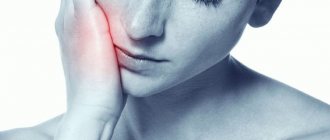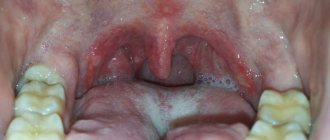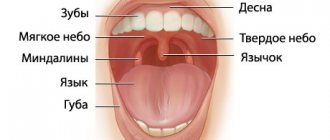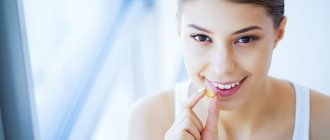September 9, 2022 Which remedy should I choose for a sore throat or diseases of the oral mucosa? Almost all diseases of the oral cavity are accompanied by inflammation. Inflammation is a pathological process that develops in response to a damaging factor.
There are three stages of inflammation:
- 1. Damage to cells and tissues. At this stage, symptoms of the disease appear, including pain.
- 2. Increased vascular permeability , release of inflammatory mediators. Swelling appears and symptoms persist.
- 3. Restoration of damaged tissues. At this stage, recovery occurs.
Therefore, a remedy for the treatment of inflammatory diseases of the oral cavity must eliminate pain, inflammation and pathogens.
Various drugs are used to treat inflammatory diseases, including antiseptics and NSAIDs.
Content:
- The importance of choosing the right medicine
- Conditions that must be met by high-quality compositions 2.1. Iodine preparations 2.2. Chlorine 2.3. Preparations based on hexethidine
- For what purpose is it used?
- Indications for use
- How to rinse your mouth correctly
For various dental diseases, doctors often prescribe oral antiseptics.
They reduce the severity of painful symptoms, wash away pathogens from mucous membranes, and improve local blood circulation. With their help, it is possible to slow down the spread of microbial flora and speed up regeneration reactions. of mouth antiseptics on the market , but this does not mean that all of them are safe and effective. During treatment, it is necessary to use exactly the product prescribed by the dentist. Self-selection of medications often makes therapy ineffective or creates conditions for relapse of infection.
The importance of choosing the right medicine
It is impossible to completely destroy microorganisms living in the human mouth. But when treating some diseases and conditions, it is necessary to temporarily reduce their number for a short time. Modern antiseptics help a lot with this.
It should be understood that those solutions that are used to treat the skin should not be taken by mouth. Firstly, it is fraught with poisoning. All sanitizers for external use are not intended for oral use.
Secondly, such therapy is always pointless. This is explained by the fact that the human mouth is inhabited by bacteria. Unsuitable products are inactivated by salivary proteins. This means that they do not work on the mucous membranes of the tongue and gums.
How do antiseptics work?
Antiseptics are a group of drugs that are used to destroy microorganisms on the surface of the skin and mucous membranes. In everyday life, they are often used to treat wounds (for example, hydrogen peroxide, chlorhexidine).
Antiseptics cause protein coagulation, as a result of which the sedimentation of microbial cell proteins prevents the formation of protein chains. Some groups of antiseptics cause the death of microorganisms through oxidation or increase the permeability of the microbial cell membrane and cause its death. Alcohol antiseptics dehydrate microbial cells, causing them to die.
Conditions that quality compounds must satisfy
Good developments used by dentists for aseptic purposes must meet a number of requirements:
- exhibit high activity against fungi, viruses, bacteria;
- provide a reliable clinical effect when used in low concentrations;
- in the case of systemic absorption, do not have a pronounced negative effect on the body or internal organs;
- be characterized by a minimal risk of synthesization;
- do not cause poisoning if used in the dosages established by the manufacturer;
- have a neutral smell and taste.
Among the most popular medications that meet these requirements:
- made from iodine;
- including chlorine;
- containing hexetidine.
Let's look at each type of mouth antiseptic in more detail.
Iodine preparations
Iodine is a substance that exhibits pronounced antiseptic properties. It destroys many fungi and microbes and acts as an effective antiprotozoal. Relieves pain, deodorizes, helps to quickly stop bleeding. They are allowed to cauterize wounds.
When treating mucous membranes, undiluted iodine is not used - it must be diluted in the required proportion. Otherwise, you can get a burn to the delicate membranes, which will take a long time to heal.
Iodine must not be combined with alkali, mercury, enzymes, or oxidizing agents. It is also pharmacologically incompatible with ammonia and ethers.
Chlorine
The most prominent representative of the chlorine-containing group is chlorhexidine, a biguanide derivative. It oxidizes and chlorinates proteins, causing their denaturation. As a result, a pronounced deodorizing and antiseptic effect is ensured, pathogenic tissues are destroyed.
Chlorhexidine is found in many oral antiseptics. It is even included in preventive toothpastes. It destroys gram-negative and gram-positive bacteria, fungi, anaerobes, herpes, facultative aerobes. With regular use, the content of pathogenic microorganisms in saliva is reduced by approximately 80-90%. As a result, the rate of plaque deposition is reduced and stone prevention is ensured.
The therapeutic effect of chlorhexidine is explained by the interaction of its positively charged molecules with negative groups of molecules in the bacterial cell wall. The component quickly penetrates the inflammatory focus, reaches the cytoplasmic layers of the microorganism and kills it.
Interestingly, the product is selectively absorbed onto enamel hydroxyapatite . This means that it does not allow bacteria to multiply on the surface of the dental crown. Since it binds tightly to proteins, the therapeutic effect is prolonged - the release of antiseptic substances occurs gradually.
In addition to antibacterial activity, chlorhexidine also exhibits a weak analgesic effect. It is important to remember that its use on an ongoing basis leads to dysbacteriosis. Therefore, there is no need to use chlorhexidine-containing drugs on an ongoing basis.
Do not combine the additive with soap, alkalis, or anionic detergents. It should be taken into account that it increases the sensitivity of the human body to chloramphenicol, cephalosporins, and aminoglycosides.
Preparations based on hexethidine
Hexethidine is a cell membrane destroyer. It accelerates the death of pathogenic organisms and disrupts the synthesis processes necessary for the spread of pathogenic flora. The antifungal activity of the drug is associated with its ability to interfere with the formation of compounds necessary for the formation of the fungal membrane.
It has been established that hexetidine is effective in pathologies caused by:
- mushrooms of the genus Candida;
- Proteus;
- Pseudomonas aeruginosa.
Medicines containing the component relieve pain, stop the spread of inflammation, deodorize and envelop wounds. They help with candidiasis, stomatitis, glossitis, periodontal disease, aphthae, and increased bleeding of the gums. Hexethidine is allowed to treat microtraumas and purulent-inflammatory areas. It is also used in the antiseptic treatment of root canals in the treatment of periodontitis and pulpitis.
What types of mouth rinses can there be?
For self-hygiene, solutions with antibacterial, antiseptic, mineralizing, anti-inflammatory, and antifungal effects can be used. It is better to use a rinse selected by your dentist or hygienist, taking into account the condition of your teeth and gums.
Mineralizing. The basis of the solution is sodium fluoride or olafur. This is a mineral component that can penetrate the enamel structure and strengthen it. After rinsing, a protective film is formed on the surface of the teeth. It lasts for several hours, “saturating” the enamel with minerals. The use of such rinses reduces the risk of caries and reduces the sensitivity of enamel.
Antiseptic. The main component may be chlorhexidine, triclosan, or benzydamine in low concentrations. The solution destroys bacteria, protects against gum disease, slows down the formation of tartar, and improves the condition of gingivitis and some other diseases. After tooth extraction, rinsing with antiseptic solutions may be prescribed to reduce the risk of inflammation or dry socket formation. Rinse aids with an antiseptic effect are used as prescribed by the attending physician. They are usually used as part of complex therapy in the treatment of periodontitis, gingivitis and other inflammatory diseases. You cannot use them for too long: this is dangerous due to dysbacteriosis of the oral cavity, dry mucous membranes, and the appearance of halitosis.
Health-improving. They are made from extracts or decoctions of herbs, using essential oils. The effect is mild, supportive or preventive (not pronounced enough if treatment of existing diseases is needed). Such rinses can contain extracts of chamomile, myrrh, sage, eucalyptus, sea buckthorn, hawthorn, essential oil of geranium and other plants. Their effect is anti-inflammatory, restorative, restoring local immunity. Such products are used as a means of daily hygiene. Even with long-term use they do not cause side effects.
Alcohol based. They are classified as antiseptic, used as prescribed by a doctor, the ethanol content can be up to 27%. Effective for halitosis and inflammatory diseases of the oral cavity. They cannot be used by minors, people for whom alcohol is contraindicated, or drivers (after rinsing, the breath may contain alcohol vapor, and this is recorded during testing with a breathalyzer).
Some rinses are used as prescribed by a doctor for specific diseases or conditions. They may include:
- diphenhydramine - for a local allergic reaction;
- xylocaine or lidocaine - anesthetic effect (temporarily removes sensitivity);
- nystatin, betamethasone, stomatidine - for aphthous stomatitis and other acute inflammations;
- benzydamine is a pain reliever.
For what purpose is it used?
Antiseptic solutions, gels and ointments are used for dental pathologies that require an integrated approach. They allow you to quickly stop the inflammatory process, efficiently cleanse the mucous membranes of infectious agents, and reduce pain in the teeth and gums. Their use is relevant during the recovery period after dental surgery (including the removal of a diseased tooth), to relieve swelling, and eliminate foul odor.
It should be remembered that drugs of this group can cause negative side reactions. So, sometimes instead of the long-awaited recovery, patients receive:
- tissue irritation;
- itching;
- peeling;
- increased sensitivity of the gums.
If such negative symptoms appear, you should stop treatment and get a second dental consultation . It is possible that the disorder was caused by other drugs that the patient applied to the tissue in parallel with the disinfectant medication. Therefore, it is advisable to immediately clarify the situation.
Indications for use
Each medicine has its own indications for use. Among the common diseases that are successfully treated with the described dental medications are:
- stomatitis;
- tonsillitis;
- angina;
- periodontal disease;
- periodontitis;
- gingivitis;
- ulcers;
- period of gum recovery after tooth extraction.
Medicines reduce the risk of infection and speed up healing if bacteria have entered the wound. But in order to get positive dynamics with their help, you must strictly follow all medical prescriptions and rinse regularly.
How to rinse your mouth correctly
In many ways, the results of the procedure are determined by the correctness of its implementation. These are the basic rules that dentists are asked to adhere to:
- Regularity. There is no point in rinsing your teeth and gums only when the urge arises. If the dentist says to use the solution every few hours, that’s what you should do. Otherwise, it will not be possible to achieve positive dynamics.
- Under no circumstances should the prepared medicine The optimal temperature is 36-40 degrees Celsius. If a hotter liquid is used, the affected area will heat up, and high temperatures are known to create suitable conditions for the further spread of pathogenic organisms.
- Do not swallow antiseptic. Most of the drugs in the group presented on the pharmaceutical market are not intended for internal use. They negatively affect the functioning of the gastrointestinal tract.
- You don’t just need to take the solution into your mouth and immediately spit it out, but hold it in the area of the affected tissue for about a minute. Such mouth baths are considered the most effective.
Using antiseptics wisely and giving preference to proven means, you can significantly bring recovery closer even with advanced dental diseases.
How do non-steroidal anti-inflammatory drugs work?
NSAIDs (non-steroidal anti-inflammatory drugs) are a group of drugs that have anti-inflammatory, analgesic and antipyretic effects. Such drugs are known to everyone who has ever had a headache (for example, acetylsalicylic acid and ibuprofen).1
NSAIDs block the synthesis of special enzymes, thereby disrupting the production of prostaglandins E2 and I2 (physiologically active substances in our body), which are mediators of inflammation and cause swelling, fever and enhance the functioning of pain receptors.









